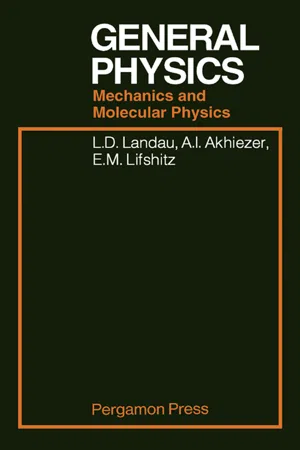
This is a test
- 382 pages
- English
- ePUB (mobile friendly)
- Available on iOS & Android
eBook - ePub
Book details
Book preview
Table of contents
Citations
About This Book
Presents, at a level suitable for undergraduates and technical college students, the basic physical theory of mechanics and the molecular structure of matter. The material contained in the work should correspond quite closely to courses of lectures given to undergraduate students of physics in Britain and America.
Frequently asked questions
At the moment all of our mobile-responsive ePub books are available to download via the app. Most of our PDFs are also available to download and we're working on making the final remaining ones downloadable now. Learn more here.
Both plans give you full access to the library and all of Perlego’s features. The only differences are the price and subscription period: With the annual plan you’ll save around 30% compared to 12 months on the monthly plan.
We are an online textbook subscription service, where you can get access to an entire online library for less than the price of a single book per month. With over 1 million books across 1000+ topics, we’ve got you covered! Learn more here.
Look out for the read-aloud symbol on your next book to see if you can listen to it. The read-aloud tool reads text aloud for you, highlighting the text as it is being read. You can pause it, speed it up and slow it down. Learn more here.
Yes, you can access General Physics by L D Landau in PDF and/or ePUB format, as well as other popular books in Physical Sciences & Physics. We have over one million books available in our catalogue for you to explore.
Information
CHAPTER I
PARTICLE MECHANICS
Publisher Summary
The fundamental concept of mechanics is that of motion of a body with respect to other bodies. The relativity of motion arises from the relativity of the concept of space itself. This chapter discusses the principle of the relativity of motion. It is reasonable to begin the study of the laws of motion by considering the motion of a body of small dimensions. The motion of such a body is especially simple because there is no need to take into account the rotation of the body or the relative movement of different parts of the body. A body whose size may be neglected in considering its motion is called a particle and is a fundamental object of study in mechanics. The possibility of treating the motion of a given body as that of a particle depends not only on its absolute size but also on the conditions of the physical problem concerned. The position of a particle in space is defined by specifying three coordinates, for instance, the three Cartesian coordinates x, y, z. For this reason, a particle is said to have three degrees of freedom. The motion of a particle is described by its velocity. The chapter also discusses momentum, motion under reactive forces, centre of mass, acceleration, force, dimensions of physical quantities, motion in a uniform field, work and potential energy, the law of conservation of energy, internal energy, boundaries of the motion, elastic collisions, and angular momentum. Besides energy and momentum, another vector quantity called angular momentum is conserved for any closed system. This quantity is the sum of the angular momenta of the individual particles. The law of conservation of angular momentum is valid for a closed system and not, in general, for the individual particles forming the system; however, it may be valid for a single particle moving in a force field.
§1. The principle of the relativity of motion
The fundamental concept of mechanics is that of motion of a body with respect to other bodies. In the absence of such other bodies it is clearly impossible to speak of motion, which is always relative. Absolute motion of a body irrespective of other bodies has no meaning.
The relativity of motion arises from the relativity of the concept of space itself. We cannot speak of position in absolute space independently of bodies therein, but only of position relative to certain bodies.
A group of bodies which are arbitrarily considered to be at rest, the motion of other bodies being taken as relative to that group, is called in physics a frame of reference. A frame of reference may be arbitrarily chosen in an infinite number of ways, and the motion of a given body in different frames will in general be different. If the frame of reference is the body itself, then the body will be at rest in that frame, while in other frames it will be in motion, and in different frames it will move differently, i.e. along different paths.
Different frames of reference...
Table of contents
- Cover image
- Title page
- Table of Contents
- Copyright
- PREFACE
- Chapter 1: PARTICLE MECHANICS
- Chapter 2: FIELDS
- Chapter 3: MOTION OF A RIGID BODY
- Chapter 4: OSCILLATIONS
- Chapter 5: THE STRUCTURE OF MATTER
- Chapter 6: THE THEORY OF SYMMETRY
- Chapter 7: HEAT
- Chapter 8: THERMAL PROCESSES
- Chapter 9: PHASE TRANSITIONS
- Chapter 10: SOLUTIONS
- Chapter 11: CHEMICAL REACTIONS
- Chapter 12: SURFACE PHENOMENA
- Chapter 13: MECHANICAL PROPERTIES OF SOLIDS
- Chapter 14: DIFFUSION AND THERMAL CONDUCTION
- Chapter 15: VISCOSITY
- INDEX